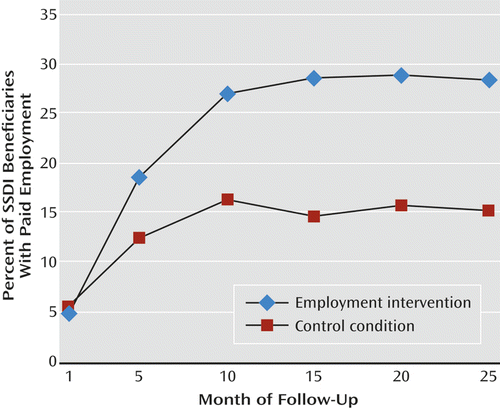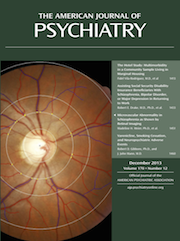In This Issue

Systematically combining vocational help, medication management, and services such as substance abuse treatment increases the likelihood that Individuals receiving Social Security Disability Insurance (SSDI) for psychiatric impairment will find paid employment (figure). Drake et al. (CME, p. Original article: 1433) compared such an intervention with usual services in 2,055 SSDI beneficiaries over 2 years. More of those receiving the intervention were employed at some point, 60% versus 40%, and they used fewer hospital and emergency services. They did not earn enough to relinquish SSDI, and editorialist Frank (p. Original article: 1379) suggests a preventive approach, keeping people at work during the early stages of illness.
Anesthetic agents, particularly propofol, may produce persistent memory loss in patients under severe psychological stress. Roberts et al. (p. Original article: 1398) propose a “two-hit” explanation—multiple recent stressors plus propofol anesthesia—for the prolonged retrograde amnesia of a woman who underwent an upper endoscopy and afterward was unable to recall even her own identity. Seven years earlier she had experienced a dissociative fugue during a divorce, suggesting a vulnerability to psychogenic memory loss. Thus, a previous history of dissociative episodes may be a consideration in exposing patients to anesthetic agents.
How Does Light Therapy Work?
One possible agent of sunlight’s physiological effects on mood is melanopsin, a photoactive pigment in cells of the inner retina. Its absorption spectrum peaks in blue wavelengths, which have been studied in light therapy for seasonal affective disorder. Oren et al. (CME, p. Original article: 1403) also describe processes in which light stimulates tetrapyrrole pigments, including hemoglobin and bilirubin, which may act as blood-borne photoreceptors and regulate “gasotransmitters,” such as carbon monoxide and nitric oxide, when exposed to light in the eye.
Retinal Vasculature in Schizophrenia
Individuals who developed schizophrenia by age 38 had wider retinal venules, i.e., venous microvessels, than healthy participants in a population study in Dunedin, New Zealand. Hypertension and other conditions did not account for the difference, report Meier et al. (CME, p. Original article: 1451). Wider venules were also associated with subthreshold psychosis symptoms in the entire cohort and with childhood psychosis symptoms. Retinal and cerebral microvessels are structurally and functionally homologous, and Malaspina describes in an editorial (p. Original article: 1382) how vascular dysfunction could contribute to schizophrenia but might also signal systemic disease.
Taking varenicline for smoking cessation does not raise the risk of suicidal thoughts or behavior, depression, or aggression or agitation. Analysis of 17 randomized controlled trials by Gibbons and Mann (p. Original article: 1460) showed that the risks were not heightened even among patients with psychiatric disorders and that varenicline was more effective than placebo or bupropion. In an editorial, Evins (p. Original article: 1385) advises clinicians to help patients quit smoking and discuss possible short-term effects, including the nausea and vivid dreams associated with varenicline.
Medications associated with a long QT interval include haloperidol, phenothiazines, fluoxetine, citalopram/escitalopram, methadone, sertindole, and clotiapine (the last two are not used in the U.S.). The likelihood of a long QT interval increases if a patient taking one of these drugs has hypokalemia, hepatitis C, HIV, or abnormal T wave morphology. Girardin et al. (p. Original article: 1468) discovered these relationships from routine electrocardiograms of 6,790 patients admitted to a Swiss public psychiatric hospital over 5 years. Of 62 patients with drug-induced long QT, five died suddenly and seven developed torsades de pointes within 72 hours after long QT detection.



